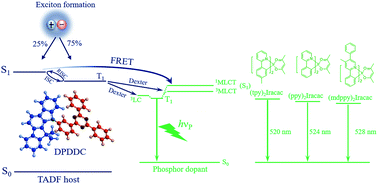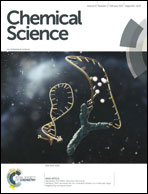Stable green phosphorescence organic light-emitting diodes with low efficiency roll-off using a novel bipolar thermally activated delayed fluorescence material as host†
Abstract
A novel bipolar hosting material, 11-(3-(4,6-diphenyl-1,3,5-triazin-2-yl)phenyl)-12,12-dimethyl-11,12-dihydroindeno[2,1-a]carbazole (DPDDC), was designed, synthesized, and characterized for green phosphorescent organic light-emitting diodes (PhOLEDs). The DPDDC exhibits excellent hole and electron transport properties, superior thermal stability, a high glass-transition temperature and a small singlet-triplet energy gap for efficient reverse intersystem crossing from triplet to singlet, reducing the triplet density of the host for PhOLEDs. The electrophosphorescence properties of the devices using DPDDC as the host and three green phosphorescent iridium(III) complexes, bis(2-(4-tolyl)pyridinato-N,C2′)iridium(III) acetylacetonate, bis(2-phenylpyridine)iridium(III) acetylacetonate, and bis(4-methyl-2,5-diphenylpyridine)iridium(III) acetylacetonate [(mdppy)2Iracac] as the emitter were investigated. The green PhOLED with 5 wt% (mdppy)2Iracac presents an excellent performance, including a high power efficiency of 92.3 lm W−1, high external quantum efficiency of 23.6%, current efficiency roll-off as low as 5.5% at 5000 cd m−2 and a twentyfold lifetime improvement (time to 90% of the 5000 cd m−2 initial luminance) over the reference electrophosphorescent device.


 Please wait while we load your content...
Please wait while we load your content...